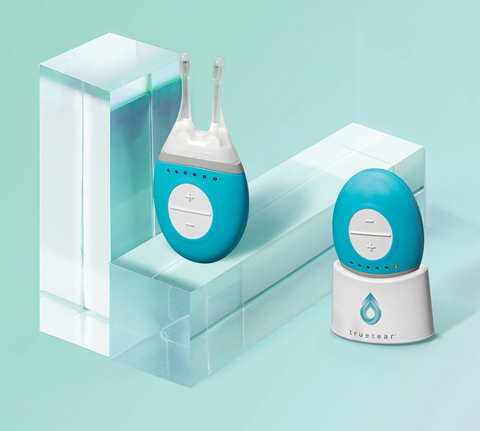 |
Neurostimulation has been an invaluable addition to the medical field since the 1950s with the invention of the first implantable pacemaker.1
Today, it’s used in implantable defibrillators and cochlear implants and for treating chronic pain, refractory epilepsy, Parkinson’s disease and essential tremor, obsessive- compulsive disorder, obesity, depression and migraine prophylactically.2 As a means of applying stimulation to regions of the nervous system to alter neurophysiological signals affecting tissues and organs, it has the potential to affect almost any part of the body—and that includes the eyes.3
For one, the Argus II retinal implant (Second Sight) provides some hope for patients with retinitis pigmentosa. It is intended to stimulate the intact inner retinal neurons.4
The latest neurostimulation device to hit the eye care market, TrueTear (Allergan) for the stimulation of tears in patients with aqueous tear deficient dry eye disease (DED), opens the door to new treatment options for patients looking for relief beyond artificial tears.
 |
| Although an unusual approach, this new neurostimulator may be a big help for patients looking to increase tear production. Image: Allergan |
Pathophysiology in Play
Neurostimulation provides patients an alternative option to pharmaceutical agents. Often, it is seen as more natural, as it stimulates the patient’s own neurological system to produce the signals necessary for tissue function. TrueTear, for example, stimulates cranial nerve (CN) V, which is directly responsible for innervation of the lacrimal functional unit (LFU), including the meibomian glands, goblet cells and lacrimal and accessory lacrimal glands.5 Stimulating a patient’s own tear secretion can provide the ocular surface with antibacterial components such as lyzozyme, key proteins such as lactoferrin and albumin and anti-inflammatory components.
CN V is the largest cranial nerve with three divisions: the ophthalmic, maxillary and mandibular nerves. The ophthalmic nerve, comprised of the lacrimal, nasociliary and frontal nerves, innervates the LFU.5,6 In response to any external or internal stimuli, the LFU and central nervous system (CNS) communicate via the trigeminal nerve using afferent and efferent neurons. Thus, external stimuli trigger sensory nerves on the ocular surface, as the efferent neural system involves CNS-processed signals that travel via parasympathetic and sympathetic fibers from the CNS to the sphenopalatine ganglion. The signals ultimately reach the LFU via branches of the ophthalmic nerve, which then stimulate the secretion of the aqueous glands, goblet cells and meiboiman glands.
The New Game in Town
TrueTear is a handheld device designed to deliver an electrical current to the nasal branch of the trigeminal nerve by two prongs inserted into the nasal passages.7 The power is adjustable, and patients can alter the frequency or intensity of the stimuli to minimize neuroadaptation. The device is also designed with disposable tips made of soft hydrogel.7
One of the biggest advantages to this new technology is it may allow patients to enhance their tear film, quality and function without pharmaceutical intervention.7 In clinical trials, 93% of patients were satisfied with the treatment and would recommend it to friends and family.8,9
Its Place in DED Care
TrueTear’s unconventional approach to DED treatment may slow its adoption in optometric practice. Patient education on properly placing the device for optimal neurostimulation will be key to its success. Clinicians must remember it is an adjunct to current treatment options, and many patients will continue to need treatment for other underlying dry eye issues such as obstruction, inflammation and biofilm control.10-12
While adverse events were mild in the current trials, 10.3% of study participants noted nasal pain, discomfort or burning, and other possible mild events included transient electrical discomfort, nosebleed, nasal congestion and headaches.7 More research will better outline its safety and effectiveness for longer than six months.7
Clinicians should not prescribe the device to patients with any implanted electronic device such as a pacemaker or defibrillator, those with chronic or recurrent nosebleeds or patients with bleeding conditions.7 In addition, patients with a significantly deviated septum or other issues related to anatomical access to the nasal branch of the trigeminal nerve such as reconstructive surgery or previous rhinoplasty are not good candidates.
The company estimates TrueTear’s recharging base will cost roughly $300, and the disposable tips will run about $25 to $30 per month.
TrueTear is designed to work in conjunction with our current armamentarium of dry eye products that treat meibomian gland obstruction and inflammation and support biofilm control. It may be a welcome novel treatment approach for patients not wanting to instill artificial tears.
Dr. Karpecki is a consultant for Allergan Pharmaceuticals.
| 1. Gardner J, Williams C. Responsible research and innovation: A manifesto for empirical ethics? Clin Ethics. 2015;10(1-2):5-12. 2. Danilov YP, Kublanov VS. Emerging noninvasive neurostimulation technologies: CN-NINM and sympatocorection. J Behav Brain Sci. 2014;4:105-13. 3. Zhu S, Marmura MJ. Non-invasive neuromodulation for headache disorders. Curr Neurol Neurosci Rep. 2016;16(2):11. 4. Second Sight Medical Products. New Enrollment Post-Approval Study of the Argus® II Retinal Prosthesis System. www.clinicaltrials.gov/ct2/show/NCT00407602. Accessed May 30, 2017. 5. Kossler AL, Wang J, Feuer W, Tse DT. Neurostimulation of the lacrimal nerve for enhanced tear production. Ophthal Plast Reconstr Surg. 2015;31(2):145-51. 6. Bhavsar AS, Bhavsar SG, Jain SM. A review on recent advances in dry eye: Pathogenesis and management. Oman J Ophthalmol. 2011;4(2):50-6. 7. Allergan. Allergan granted marketing authorization by the FDA for TrueTear, the first intranasal neurostimulating device proven to temporarily increase tear production. April 25, 2017. www.allergan.com/News/News/Thomson-Reuters/Allergan-Granted-Marketing-Authorization-by-the-FD. Accessed May 31, 2017. 8. Multicenter Trial Evaluating Quality of Tears Produced by Nasal Neurostimulation. April 2017. www.clinicaltrials.gov/ct2/show/NCT02385292?term=neurostimulation+and+tears&rank=1. Accessed May 31, 2017. 9. Six Month Study to Evaluate the Safety and Effectiveness of the Intranasal Lacrimal Neurostimulator. www.clinicaltrials.gov/ct2/show/NCT02526290?term=neurostimulation+and+tears&rank=3. June 2016. Accessed May 31, 2017. 10. Arita R, Morishige N, Koh S, et al. Increased tear fluid production as a compensatory response to meibomian gland loss: a multicenter cross-sectional study. Ophthalmology. 2015;122(5):925-33. 11. Hessen M, Akpek EK. Dry eye: an inflammatory ocular disease. J Ophthalmic Vis Res. 2014;9(2):240-50. 12. Rynerson JM, Perry HD. DEBS – a unification theory for dry eye and blepharitis. Clin Ophthalmol. 2016;10:2455-67. |

